Collisions, Vision Problems And Eyeworms In Birds
Ron Hines DVM PhD
 If you arrive on this page because you wanted to be more familiar with avian eyes and eye problems in general, ask me for Williams1994, Abrams2002, & Bayon2007
If you arrive on this page because you wanted to be more familiar with avian eyes and eye problems in general, ask me for Williams1994, Abrams2002, & Bayon2007
I had a particular bird vision problem in mind when I wrote this article. It is a parasite called an eyeworm. The scientific name for them is Oxyspirura. Other closely related eye parasites, like Thelazia, affect mammals as well as birds. All of them are quite flexible (opportunistic) as to the species of insect that is able to transmit them and the species of animal that serves as their final host.
Eyeworms Oxyspirura
People occasionally bring me thin wild birds with vision problems that have lead to a general unthriftiness (“disrepair”, unhealthy) due to their inability to successfully feed. In some, the causes are obvious – bird pox infection, sharp trauma, collisions, cataracts, retinal detachments, corneal lacerations and the like. I live on a major squeeze point on America’s Central Migratory Flyway,
so, in early spring and fall, a lot of injured and exhausted birds come my way. But occasionally, I have no explanation for their poor or absent vision and apparent inability to feed themselves.
I also receive a lot of locally nestlings that have fallen with their nests in windstorms or simply been pushed out by their larger nest mates. I always attributed that to a hatchling emerging from its egg a day or so later than its siblings, perhaps a hen that did not sit tight or one that did not turn an egg properly. Those things do happen. Once a hatchling is born with even a small size disadvantage to its nest mates, it is less able to compete for food and the size difference continues to magnify day by day.
I have noticed that some songbird nestling are not only small, they do not appear to clearly see the food in the forceps I offer them. They respond to my proximity and call for food – but their eyes do not track me. They sometimes tilt their head and neck persistently to one side (torticollis). They rarely survive – even when I move them to an individual box and feed them separately.
Wild bobwhite quail are well studied in Texas. That is because they support a sizable hunting industry. Quail numbers have been decreasing for many years. A&M University’s Kingsville campus has been looking for a cause for the quail population decline. They considered many possibilities: native habitat destruction, overgrazing, changing farm crop preferences, predation, indiscriminate pesticide and herbicide use, intestinal parasites (eg cecal worms, coccidiosis), mercury pollution, mosquito- borne viruses like West Nile. But none appear to account for the decrease in quail numbers.
Eventually, they focused on a particular eyeworm, Oxyspirura petrowi. There are several species of oxyspirura that parasitize the eyes of birds. They can be found all over the world. In Texas quail, these worms range in length from about an eighth to three quarters of an inch. (ask me for Dunham2013) The male worms do not reach as large a size as the female worms do.
Quail are only one of the bird species that this worm affects. The insect hosts of the eyeworm form an equal part of the diets of many common song birds. We know very little about what effects eyeworms might have on them. Curve-billed thrashers and mockingbirds are just two examples in which these parasites have been verified.
Avian eyeworms are a two-host parasite. That is, one stage develops in one species of animal (an intermediate host insect) and the final stage develops in a bird (the adult or definitive parasite’s host) (= a digenetic or heteroxenous life cycle). Adult eyeworms lives on and in the structures that surround the bird’s eyes: On the cornea, under the 3rd eyelid, in spaces next to the eye ball that are not visible (the conjunctival sac), in the lacrimal duct that conveys tears to the nose, adjacent to the lacrimal gland that produces tears and adjacent to the harderian gland (a gland probably associated with eye immunity but whose functions are not fully understood). (ask me for Dimitrov2011, Burns1979 & Wight1971)
You can not see the bird’s harderian gland; but the gland is a rich source of food for eyeworms. It is also located close to the bird’s optic nerve, a key element for proper vision. I drew a schematic representation of it in the diagram above.
Eyeworms have also been found in the sinus spaces that permeate the bird’s skull. These parasites have teeth, and, in the process of feeding on the bird’s tissue and blood, they are capable of causing considerable damage. That is particularly true if many are present. It might also be true if the bird is one of the small wild species (although similar parasitic worms adjust their final body size somewhat to accommodate the size of the host’s eye structure). Once inside a bird, these parasites can move freely from eye to eye through the sinus passages. (ask me for Permin1998) When disturbed, they are known to evade capture by moving deeper into the structure of the eye.
When eyeworms are mature and two of them have mated, the female lays numerous eggs that pass through the bird’s nasolacrimal ducts (tear ducts) with the birds tears, on into the mouth from where they are swallowed. The eggs eventually pass out in the bird’s feces. As far as we know, these eggs are not now infective for other birds. But if the eggs are consumed by an insect, they hatch into small larva, which encyst within the insect’s body. When an unfortunate bird eats that insect or feeds that insect to its youngster, the larval eyeworms escape, rapidly move back up the bird’s esophagus, back up through the nasolacrimal duct and into the new bird’s eye structures. There they mature and repeat their life cycle in about another 4-6 weeks. (The larva get to the bird’s eye very fast after the insect is eaten, some say in 5 minutes, others 20 minutes). (ask me for Schwabe1950))
Wood cockroaches, particularly one with the name of Pycnoscelus surinamensis , are commonly infected with eyeworm larva because bird feces constitute one of their sources of food. But any ground dwelling insect can probably serve as the intermediate host as well. In one study, 38% of wood cockroaches, 27%of field crickets and 31% of grasshoppers contained eyeworm larva. (ask me for Presley2013) Quail and ground feeding, wild chicken-like birds are documented to have high levels of eyeworms. Perhaps that is because they are hunted and closely examined while other wild birds are not. They were found in up to 56% of bobwhite quail in one Texas study. Other studies found them in up to 33% of the quail.
But we know that eyeworms are not limited to quail and chickens. It appears that any wild birds that feeds on ground dwelling or even higher flying insects or those that seasonally feeds these insects to their young are at risk. In another study, eyeworm DNA was found in mockingbirds and a thrasher. Other eyeworms have also been reported in woodpeckers, harrier hawks, kites, fulvous owls and cockatoos. (ref1, ref2, ref3)
What Harm Do Eyeworms Cause And What Signs Might I See ?
That could be quite variable and little is known, other than in quail and poultry. If there are only one or two parasites, if they are located superficially and if the infected bird is a large species, perhaps they are only a minor annoyance. When another Oxyspirura (O. mansoni) infects free ranging domestic chickens, superficial eye inflammation (conjunctivitis) and an eye discharge are common. The birds often loose weight and rub their eyes. More severely parasitize chickens can develop cloudy corneas and visual obstruction severe enough to prevent feeding.
The problem is that eyeworms do not limit themselves to the visible portion of the bird’s eye. And they do not live on the nutrients in tears as was once supposed. They have teeth. They feed actively on the tissue surrounding the eyeball. They can also migrate to behind the eye where some believe that they can exert pressure on the bird’s optic nerve or displace the harderian gland enough to do so. (ask me for Dunham2015, Xiang2013 & Bruno2015) That disruption of vision cause birds to loose weight to the point where they eventually cannot survive in the wild.
I have seen ringneck pheasant crash inexplicably into power lines in Illinois. In West Texas I am told that it is not that uncommon to have quail crash into houses, barns, and cars. Perhaps heavy eyeworm infestation accounts for some of those “accidents” and some of the vision problem in birds brought to me.
How Can I Check Birds For Eyeworms?
When eyeworms are situated over the surface of the cornea and the other surrounding visible portions of the eye, they are easily seen once they mature. The problem is that they can be located in areas surrounding the eyeball that cannot be seen in a living bird. Sometimes, a flotation of feces from the bird will show embryonated eyeworm eggs with the larval eyeworm folded up within. That confirms the diagnosis. However, those eggs can be easily missed and appear only intermittently. As stated in the Merck Manual “A clinically feasible technique for reliable detection of adult eyeworms is [currently] lacking.“
But in 2013, a research scientist adapted a sensitive PCR test to detected the presence of eyeworm eggs or their body proteins in bird feces. As of mid 2019, that test was not commercially available. But it might be offered in the future (perhaps by Texas Tech ) as a trial is in progress there to assess the effectiveness of a medicated quail feed in eliminating this parasite. (ask me for Ruzicka2015)
How Can I Eliminate Eyeworms ?
Any adult eyeworms that are visible can be gently plucked out of the bird’s eye with pointed tweezers. That is best done with the bird tightly restrained or after the eye has been anesthetized with a drop of lidocaine 2% gel or 0.5% proparacaine (Alcaine®). Parasites that are not embedded can often be flushed out with normal saline solution drawn into a 3 ml syringe fitted with a 23-gauge needle.
Eyeworms that are deeper into the surrounding eye tissue and ducts cannot be treated that way and it is quite possible that some exist in addition to the parasites that are visible. So for all birds, a drop of ivermectin, instilled into each eye is the current treatment of choice. It is an “off label” use. That means that no agency or veterinarian takes responsibility for its safety or effectiveness. Ivermectin is sold as a 1% solution for livestock and horses. One drop of the undiluted solution is considerably too much for a 500 gram (~ 1 pound) bird. A 1% solution contains 10 mg of ivermectin/ml. In one study 0.005 mg, 0.01 mg, 0.02 mg, and 0.05 mg were all sufficient to kill all visible eyeworms in one group of chickens. Eyeworms were successfully eliminated from partridges that normally weight 202-232 grams with 0.043 mg (43 mcg) of ivermectin. That is very close to the most common dose veterinarians use for all species is 2–mcg/Kg (except never in turtles and tortoises and with caution and a lower dose in felines and a few dog breeds). (read here)
For good measure, that treatment should probably be repeated a week later. The purchased product should not be diluted until it is drawn into a tuberculin syringe shortly before each use. In some species and for some uses, ivermectin is given by injection or orally. It does not appear to be as effective in destroying eyeworms when given that way.
Stories circulate that some birds cannot tolerate ivermectin. As I mentioned earlier veterinarians know that dogs with certain genetics and certain reptiles have that problem as well. ( read here & here ) There is also a report in Harrison and Harrison’s avian medicine text that 0.0064 mg of topically applied ivermectin preparations has been toxic in finches. That author preferred the water-based horse ivermectin formula to the propylene glycol-based cattle/pig formula. In mammals (dogs, humans), ivermectin has also cause reactions when the larva of other nematode parasites were circulating in high numbers in the blood where they were too suddenly destroyed . (read here)
Oral fenbendazole (Panacur® or Panacur granules ) is probably also effective in destroying eyeworms when given mixed with the bird’s dry food at a concentration of 100 mg/Kg (100 parts per million) of diet for 7 days (ref) or 5 mg/kg body weight when given orally for five days. The drug is quite stable. It does not break down in sunlight and it is not soluble in water. So rain should not dissolve it. In the UK, it has been used to rid grouse of other nematodes. (ask me for Griffith2014 & Newborn2002)
Fenbendazole, at a considerably higher dosage was suspected of being toxic to pigeon-like birds and some other exotic birds housed at the San Diego Zoo. The drug has also caused feather abnormalities in immature birds or when given preceding a molt.
Texas Tech University has a pending FDA minor species approval request pending for a similar fenbendazole-medicated feed product to be used for eyeworm control in quail.
An over-the-counter patent medicine suggests its use for eliminating eyeworms in domesticated poultry ( VetRx Poultry Remedy™). I do not know of any studies that ever found it effective. These worms rapidly move away from things that are foreign to the eye, moving to structures like the lacrimal duct or harderian gland, frontal sinuses or the other eye for refuge. The product’s ingredients, camphor, Canada balsam, rosemary and oregano oil and alcohol could easily have that effect.
Ivermectin is one of a class of medications called Avermectins Two others in the class, doramectin and moxydectin-containing drops (Advantage Multi® aka aka Advocate Spot On®) placed on the body – not in the eye – will also kill eyeworms in mammals. But I have never used them in birds nor do I know of anyone who has.
If you run a bird rehabilitation center, it needs to be kept clean to minimize cockroaches. Boric acid powder, boric acid and sugar solutions and cockroach traps are suitable control method in a rehab center environment. Sow bugs, pill bugs and earthworms can also carry other bird nematodes when they have been exposed to infected bird feces; so housing multiple injured or orphaned birds from different sources together or crowding is never a good idea.

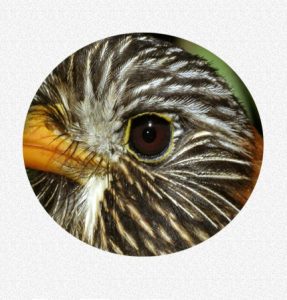
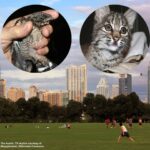
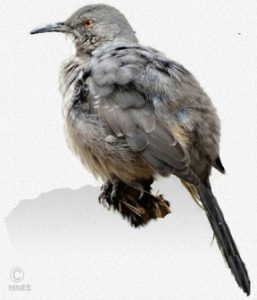
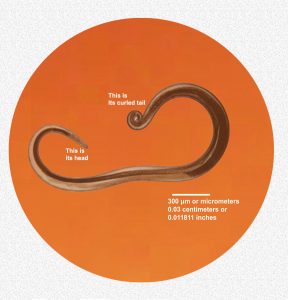
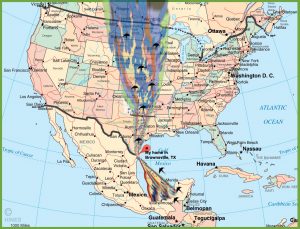
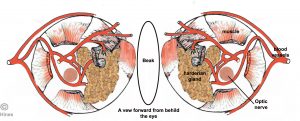
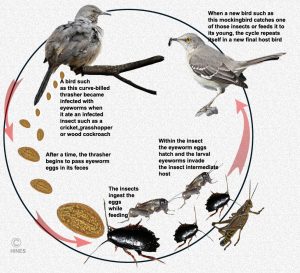
 Dear reader, Besides your donations, Visiting the products that Google chooses to display on this webpage helps me pay the cost of keeping this article on the Web. As you know, sites like mine that are not designed to make money are getting harder and harder to find. Best wishes, Ron Hines
Dear reader, Besides your donations, Visiting the products that Google chooses to display on this webpage helps me pay the cost of keeping this article on the Web. As you know, sites like mine that are not designed to make money are getting harder and harder to find. Best wishes, Ron Hines